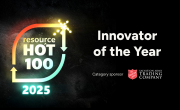Redefining ‘precious’
 The conjunction of events encourages me to return to a regular theme for this column, that of the recurring dilemma between consumption and ethics, and the challenges and contradictions it can often present.
The conjunction of events encourages me to return to a regular theme for this column, that of the recurring dilemma between consumption and ethics, and the challenges and contradictions it can often present.
This time, I find myself reflecting on my recent wedding and the sourcing of rings alongside the amazing tale of the Chilean miners and research I have been working on for a series of symposia I was involved in organising, looking at the future of resource management and how this might influence thinking about waste infrastructure.
The symposia research led me to some interesting recent analysis on the likely impact of mineral scarcity from The Hague Centre for Strategic Studies (the Netherlands, not our follicly-challenged Foreign Secretary). Although this is controversial (what isn’t when it comes to economics?), the researchers discuss the impact of what may eventually be seen as a third ‘super-cycle’ where the world economy enters an unusually resource-intensive phase of expansion – the first took place at the turn of the 20th century on the back of US industrialisation, the second after World War Two based on Japanese industrialisation, and the current cycle is inevitably focused on the growth of Chinese industrialisation. They describe clearly the current battle for access to various precious metals, rare earth elements (REEs) and platinum group metals (PGMs) – largely being conducted by the Chinese, Americans and Japanese in an attempt to protect access to resources for their own manufacturing base while potentially restricting access to other nations, which may well drive up prices or even lead to conflict in the worst cases. In the meantime, Europe seems largely passive, which is a concern, and should inevitably put much more emphasis on the effective capture of REEs and precious metals from products (such as WEEE) as their value continues to rise due to the scarcity of the primary resources.
The notion of what constitutes precious in the future may well not be confined to those traditional resources we love to covet – the gold and silver, platinum and suchlike. Metals that are barely recognised today may well be the gold of the future, but still gold retains the allure it has had for thousands of years despite the often horrendous cost that comes with it in terms of pollution and mortal injury to miners across the gold-mining world. The joyous human scenes we have just witnessed as the 33 Chilean miners were hauled back to the surface from their entombment 2,000 feet below ground run the risk of masking the reality of their situation – workers still struggling to make a living
in poor and unsafe working conditions in a mine that was over 100 years old and literally creaking at the seams, in order to fuel our constant demand for this precious and finite resource.
This brings me to the subject of wedding rings and what is marketed as ethical jewellery. Well, I opted for the reuse approach and now proudly sport a (literally) secondhand gold band from the 1950s, so at least no new negative environmental impact occurred for this purchase. The choice for my wife Angela was more difficult than we had thought it would be, but we found a white gold band made and certified under the Fairtrade banner by CRED and also supplied by our local family jeweller. CRED Jewellery sources gold from South American mines operating under high environmental, health and safety standards in which workers are fairly paid for their labours.
However, this appears to be a very small share of the market, meaning that much of the world’s gold is still mined in ways that neither minimise pollution nor maximise health and safety for workers. Indeed, the same concern applies to all mineral mining, and it is a stark fact that no proper records exist of mining fatalities, although an international trades union federation estimates that there are around 12,000 fatalities worldwide every year from mining.
Twelve thousand fatalities every year bring very little publicity. Thirty-three rescued miners bring global 24/7 coverage. While that tells you all you need to know about the media circus, it should also serve as a reminder of the daily drama of death that unfolds underground and underreported, which will carry on once all the cameras have gone on to another story.
Is it time to redefine what we mean by precious?





